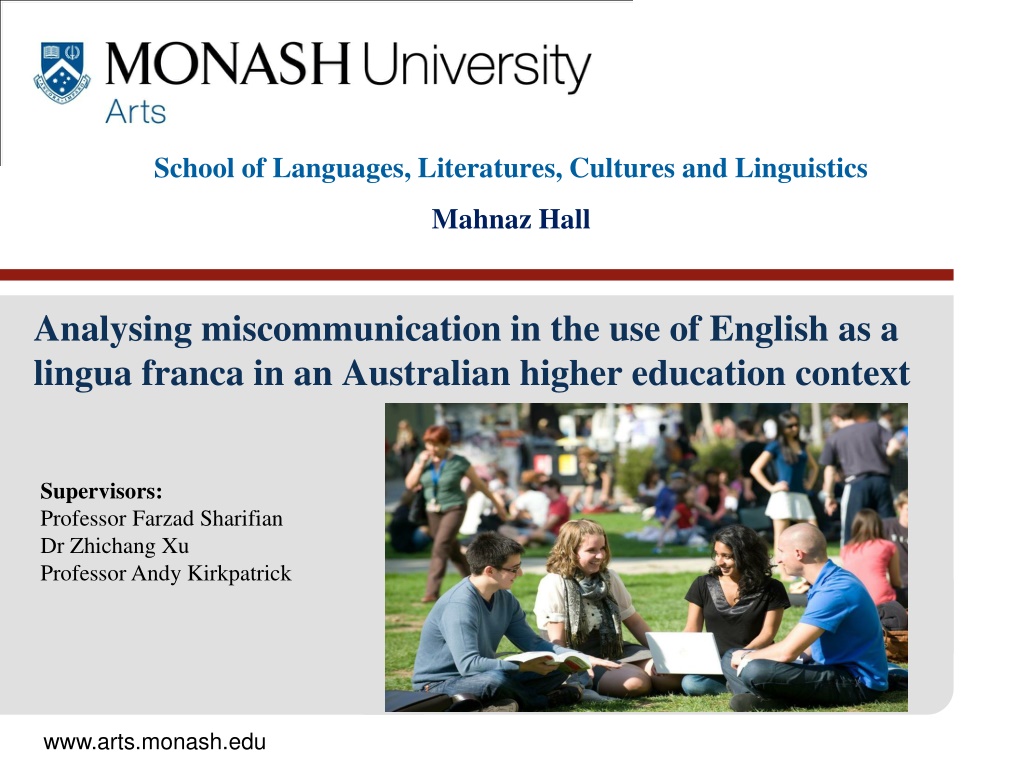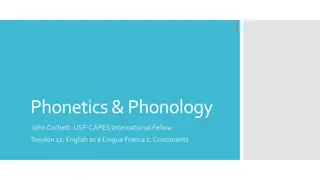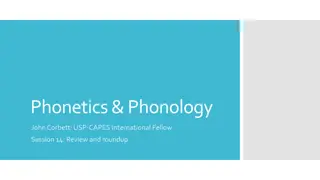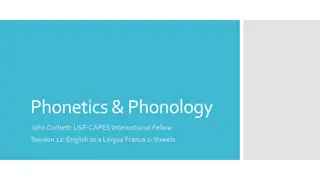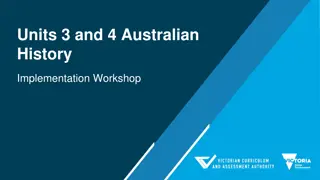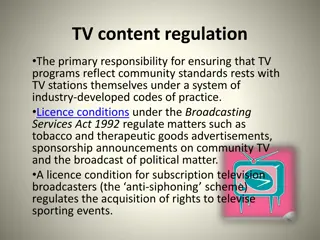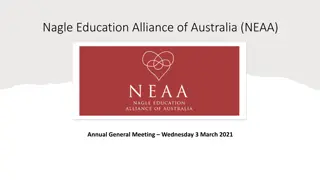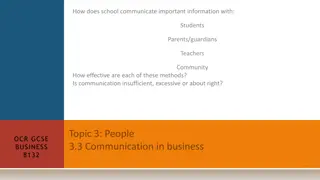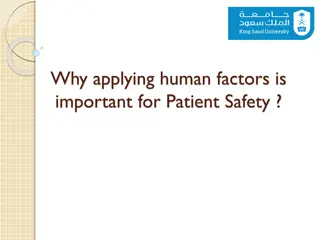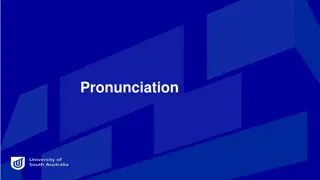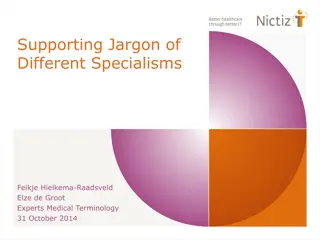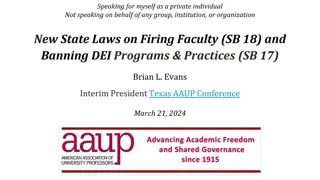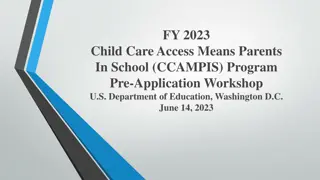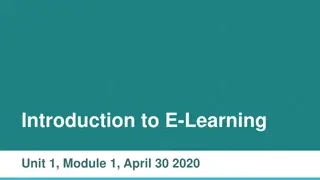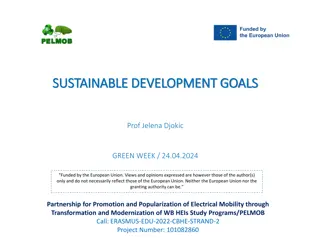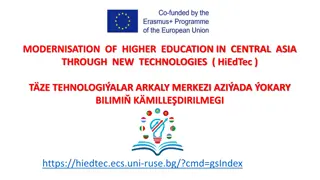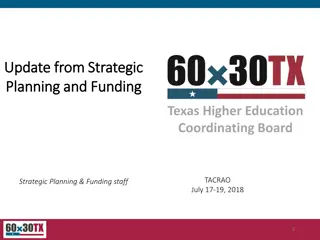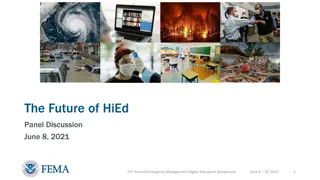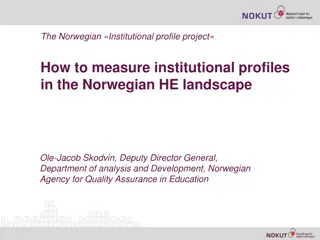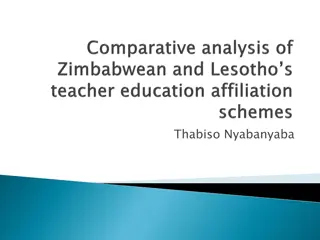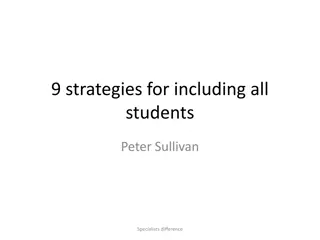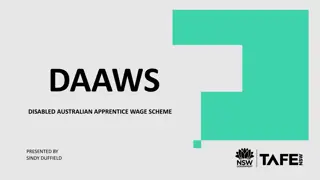Analyzing Miscommunication in English as a Lingua Franca in Australian Higher Education
Mahnaz Hall's research explores miscommunication in the use of English as a lingua franca in Australian higher education, focusing on challenges faced by international students in academic and social interactions due to language proficiency and cultural barriers. The study highlights the significance of investigating ELF interactions in informal academic settings.
Download Presentation

Please find below an Image/Link to download the presentation.
The content on the website is provided AS IS for your information and personal use only. It may not be sold, licensed, or shared on other websites without obtaining consent from the author. Download presentation by click this link. If you encounter any issues during the download, it is possible that the publisher has removed the file from their server.
E N D
Presentation Transcript
School of Languages, Literatures, Cultures and Linguistics Mahnaz Hall Analysing miscommunication in the use of English as a lingua franca in an Australian higher education context Supervisors: Professor Farzad Sharifian Dr Zhichang Xu Professor Andy Kirkpatrick www.arts.monash.edu
Previous Research into ELF To understand the use of English in today s globalised world, ELF must be one of the central concerns in this line of research (Mauranen, 2006, p. 147). Followed by the two seminal works by Jenkins (2000) on ELF phonology and Seidlhofer (2001) on the conceptualisation of ELF, as well as three major ELF corpora, VOICE, ELFA, and ACE, ELF became a distinct area of empirical research with a considerable number of research-driven and theoretical publications. www.arts.monash.edu 2
ELF in the Australian Higher Education Context English is employed as an established lingua franca in Australian universities. Students and staff originate from widely disparate cultural and linguistic backgrounds and use English in both academic and non-academic contexts. In each context, the communicating parties need to manage a lack of common ground and diversity as they speak different varieties of English and often have markedly different accents. www.arts.monash.edu 3
Continuation This diversity has recently sparked significant interest in research, particularly on the challenges students face in coping with academic and conversational English in Australia (e.g. Hellsten & Prescott, 2004; Nayak & Venkatraman, 2010; Wang & Cross, 2006; Yates & Wahid, 2013). Main findings: International students from a non-English speaking background were unable to participate successfully in classroom discussions and social interactions on campus, in particular in the company of their Australian peers due to their lack of English language proficiency, often exacerbated by cultural barriers. They were often misunderstood by academic staff or suffered from a lack of understanding of teacher expectations. www.arts.monash.edu 4
Significance of the Study Research on ELF in academia has mainly focused on formal events and largely ignored informal interactions. Students often discuss the contents of lectures or tutorials and make value judgements about their university and social lives, so it is imperative to explore ELF interactions in informal academic settings. Under-researched area considering the provenance (Australia) and setting (informal communication in a higher education context). It fills the gap between ELF research conducted in formal and informal academic contexts. www.arts.monash.edu 5
Purpose of the Study 1. To what extent is ELF communication among university students in Australia characterised by instances of overt non-understanding/ misunderstanding? 2. What are the linguistic causes for the identified instances (e.g. phonological, lexical, pragmatic, or syntactic)? 3. How non-understandings/misunderstandings are managed and resolved through strategies commonly adopted by ELF speakers? 4. What are the possible implications for English language teaching? www.arts.monash.edu 6
Analytical Framework Problematic Communication Miscommunication Non-understanding Misunderstanding (Adapted from Gass & Varonis, 1991) Non-understanding: When the listener fails to understand what has been spoken by the speaker (Kaur, 2009). Misunderstanding: A mismatch between the speaker s intended meaning and the hearer s understanding of this meaning (Tzanne, 2000, p. 34) or as defined by Mauranen (2006, p.128), a potential breakdown point in conversation, or at least a kind of communicative turbulence . www.arts.monash.edu 7
Methodology Demographic data: Location: Monash University (Clayton) Communicative events: 30 (groups of 3 to 4 participants) Participants: Total number: 107 (71 females; 36 males) Ages: 18 to 40 Fields of study: 59 (36 undergraduate; 71 postgraduate) www.arts.monash.edu 8
Continuation Countries of origin: 23 (covering all three circles) Countries of Origin Australia Hong Kong Bangladesh India China Indonesia Colombia Iran Ethiopia Japan Germany Malaysia Mexico South Korea Netherlands Sri Lanka Pakistan Thailand Philippines United States Saudi Arabia Vietnam Singapore Language data: First languages spoken: 37 Number of L1 English speakers: 14 (13%) IELTS requirement: A minimum score of 6.5 or equivalent www.arts.monash.edu 9
Continuation Research approach: Qualitative and quantitative Data collection and analysis: Transcription Audio-recording Follow-up To determine non- understandings/ misunderstandings and their linguistic causes Approx. 18 hours of naturally occurring communication VoiceScribe software Voice conventions 149,754 words www.arts.monash.edu 10
Findings: Pronunciation The results show 196 instances of overt non-understanding (160) and misunderstanding (36), primarily attributable to pronunciation, followed by lexis, pragmatics, and syntax. Note: Jenkins (2000) incorporated problematic pronunciation features in the LFC, and this study also gravitates towards investigating which phonological features are crucial for intelligibility in ELF and confirms if these features are either incorporated in the LFC or are among non- core features. www.arts.monash.edu 11
Findings: Pronunciation In total, there are 89 instances of non-understanding (64) and misunderstanding (25), of which 72 involve the segmentals and 17 relate to a suprasegmental feature. Percentage of non-understanding/misunderstanding instances involving segmental and suprasegmental features 19% Segmentals Suprasegmental 81% www.arts.monash.edu 12
Findings: Pronunciation (Segmentals) Individual consonants and consonant clusters had a more serious effect on intelligibility than vowels. Percentage of non-understanding/misunderstanding instances involving the segmentals 33% Individual Consonants 49% Consonant Clusters Vowels 18% www.arts.monash.edu 13
Findings: Pronunciation (Consonants) The main issues with consonants: The omission of the fricative /v/ in the coda position (e.g. love as [l ]) or its replacement with [b], [f] or [p] (e.g. leave as [li b]; travel as[tr f ]; Javanese as [d p ni z]). The entire deletion of dark [l] from a word (e.g. child as [t a d]) The elision of a word-final plosive /t/ (e.g. cite as [sa ]) or the replacement of this consonant with [s] (e.g. court as [k rs]). The main issues with consonant clusters: The omission of a consonant sound /k, s, d, t/ from a word-final cluster (e.g. once as [w n]). (Note: ten instances of non-understanding/misunderstanding, making this feature relatively important for preserving intelligibility) These findings are consistent with the LFC (Jenkins, 2000) and the CMACE data from South-East Asia (Deterding, 2013). www.arts.monash.edu 14
Findings: Pronunciation (Vowels) The main issues with vowels: Variation in vowel quality caused greater issues compared to vowel length There are only three instances of non-understanding/misunderstanding involving vowel length. Extract Context: MIr (male from Iran) is talking to FViet (female from Vietnam) and FMal (female from Malaysia) about movie ticket vouchers. it's about thirteen [t t ] dollars THIRTY dollars? why so expensive? thirty? or thirteen? one three 1) MIr: 2) FViet: 3) FMal: 4) MIr: www.arts.monash.edu 15
Continuation There are 21 instances of non-understanding/misunderstanding involving vowel quality, making it the most prevalent phonological feature affecting intelligibility. Extract Context: MChi (male from China) has just asked FMal1 (female from Malaysia #1) and FMal2 (female from Malaysia #2) how they spend their free time. 1) FMal1: 2) FMal2: 3) FMal1: 4) MChi: 5) FMal1: 6) FMal2: 7) MChi: i go for shopping o:r go for= =so you have lots of money [meni ]? @@@ that s cheeky many what? <1> money </1> <1> money </1> o;h money money (1) shopping @@ www.arts.monash.edu 16
Continuation These findings do not completely concur with the LFC proposal, most likely due to the multilingual backgrounds of the participants. They also differ from the conclusions of the CMACE data (Deterding, 2013) in which vowel quality is reported to have rarely caused misunderstandings. This is probably due to the fact that speakers from South-East Asia normally share common phonological features (Deterding & Kirkpatrick, 2006). www.arts.monash.edu 17
Findings: Pronunciation (Suprasegmentals) Ten instances of non-understanding/misunderstanding involved fast speech rate which was well above 4.5 syllables per second that is considered to be the average rate for conversational English in Inner Circle countries (Hewlett and Rendall, 1998, p. 68) Five of these instances were caused by unintelligible speech of L1 Australian English speakers when assessed by ELF speakers which demonstrates that intelligibility fails to be an inherent characteristic of native-speaker speech (Walker, 2010, p. 17). There were also seven instances involving syllable deletion which is a result of fast speech rate, making it 17 instances in total. www.arts.monash.edu 18
Findings: Lexis In total, there are 63 instances of non-understanding (60) and misunderstanding (3) involving lexis. (one instance of non-understanding caused a breakdown) Percentage of non-understanding/misunderstanding instances involving lexis 2% 3% Unfamiliar words Technical words Phrases Slang Idioms 24% 63% 8% www.arts.monash.edu 19
Findings: Syntax In total, there are 11 instances of non-understanding (9) and misunderstanding (2) involving syntax. Percentage of non-understanding/misunderstanding instances involving syntax 18% Verbs Articles Pronouns Word Form Sentence Structure 28% 27% 9% 18% www.arts.monash.edu 20
Findings: Pragmatics In total, there are 33 instances of non-understanding (27) and misunderstanding (6) involving pragmatics. (Four instances of non-understanding caused a breakdown, three involved an L1 Australian English speaker) Extract Context: FAus (female from Australia), FIr (female from Iran) and FThai (female from Thailand) are discussing the concept of Australia being a nanny state. 1) FAus: i think australia is such a like erm what's it called nanny (1) nanny state? 2) FIr: nanny state? (1) for example in day care? 3) FAus: oh no sorry people call it nanny state as the government brought in laws. 4) FIr: sorry i don t understand it 5) FThai: erm yeah nanny state (1) i think it's just (1) they call it nanny because you'renannying someone 6) FIr: mhm 7) FAus: you're hovering over someone making sure they do something right 8) FIr: mhm (1) complicated (1) can we talk about something else? 9) FAus: okay @@ 10)FThai: what about birthday cakes with candles @@@ www.arts.monash.edu 21
Findings: Summary Percentage of non-understanding/misunderstanding instances across the four areas 6% 17% Pronounciation Lexis 45% Pragmatics Syntax 32% www.arts.monash.edu 22
Responses to Non-understandings/Misunderstandings Note: This research acknowledges a prominence of mutual understanding between the interlocutors in the recorded data which concurs with the findings of most studies that examined communication in ELF settings (e.g. Cogo & Dewey, 2012; Deterding, 2013; Mauranan, 2006; Smit, 2010). Response Ask for clarification Ask for help Backchannel Changing the topic Correcting Laughter Silence Unawareness Pronunciation 80 0 5 0 2 0 2 0 Lexis 58 Grammar 11 0 0 0 0 0 0 0 Pragmatics 25 Total 174 1 7 5 3 1 4 1 0 2 1 0 0 1 1 1 0 4 1 1 1 0 www.arts.monash.edu 23
Implications for ELT Raise awareness of both ELF teachers and learners of English as to the likely problems that can be encountered in such a setting and the possible strategies that are used to seek conceptual clarification in order to enhance mutual intelligibility. In intercultural communication, English language learners should be introduced to cultural conceptualisations of different varieties of English and guided towards developing metacultural competence in order to interact and negotiate more effectively (Sharifian, 2014). For multilingual societies such as Hong Kong, Xu (2014, p. 155) suggests an EIL- informed and location-based pedagogy which is beneficial to both local and international students. www.arts.monash.edu 24
Continuation Kirkpatrick (2014, p. 26) proposes a lingua franca approach to teaching English in the ASEAN context, as well as provenances where English is used as a lingua franca. He also indicates the usefulness of the adoption of a lingua franca core into the curriculum . In terms of the Australian context, as international intelligibility does not correlate with being a native speaker , Australian native speakers of English should have access to courses in intercultural communication as it is a more effective way to communicate with speakers from multiple varieties of English which are widely represented in the community (Kirkpatrick, 2016, p. 293). Accordingly, speakers of English need special training to be able to successfully communicate with one another in the ELF environment. www.arts.monash.edu 25
References Cogo, A., & Dewey, M. (2012). Analysing English as a lingua franca: A corpus-driven investigation. London: Continuum. Deterding, D. (2013). Misunderstandings in English as a lingua franca: An analysis of ELF interactions in South-East Asia. Berlin: De Gruyter Mouton. Deterding, D., & Kirkpatrick, A. (2006). Emerging South-East Asian Englishes and intelligibility. World Englishes, 25(3/4), 391 409. doi: 10.1111/j.1467-971X.2006.00 478.x Gass, S. M., & Varonis, E. M. (1991). Miscommunication in nonnative speaker discourse. In N. Coupland, H. Giles & J. M. Wiemann (Eds.), Miscommunication and problematic talk (pp. 121- 145). Newburry Park, California: Sage Publications. Hellsten, M., & Prescott, A. (2004). Learning at university: The international students experience. International Education Journal, 5(3), 344-351. Retrieved from http:// ehlt.flinders.edu.au/ education/iej/main/mainframe.htm Hewlett, N., & Rendall, M. (1998). Rural versus urban accent as an influence on the rate of speech. Journal of the International Phonetic Association, 28, 63-71. doi: 10.1017/S0025100300006 253 Jenkins, J. (2000). The phonology of English as an international language: New models, new norms, new goals. Oxford: Oxford University Press. Kaur, J. (2009). Pre-empting problems of understanding in English as a lingua franca. In A. Mauranen & E. Ranta (Eds.), Englishas a lingua franca: Studies and findings (pp. 107 123). Newcastle upon Tyne: Cambridge Scholars Publishing. Kirkpatrick, A. (2014). Teaching English in Asia in Non-Anglo cultural contexts: Principles of the lingua franca approach . In R. Marlina & R. A. Giri (Eds.), The pedagogy of English as an international language: Perspectives from scholars, teachers, and students (pp. 23-156). Switzerland: Springer. Kirkpatrick, A. (2016). English as a lingua franca and educational impact in Asia. In G. Leitner, A. Hashim & H. Wolf (Eds.), Communicating with Asia: The future of English as a global language (pp. 282-295). Cambridge: Cambridge University Press. Mauranen, A. (2006). Signalling and preventing misunderstanding in English as a lingua franca communication. International Journal of the Sociology of Language,177, 123-150. doi:10. 1515/IJSL.2006.008 Nayak, R. R., & Venkatraman, S. (2010). A pilot study into international students academic culture: The context of Indian business students in an Australian university. e-Journal of Business Education & Scholarship of Teaching, 4(2), 1-12. Retrieved from http://www.ejbest.org/upload/eJBEST_Nayak_Venkatraman_2010_2.pdf Seidlhofer, B. (2001). Closing a conceptual gap: The case for a description of English as a lingua franca. International Journal of Applied Linguistics,11(2), 133-158. doi: 10. 1111/1473- 4192.00011 Sharifian, F. (2014). Teaching English as an international language in multicultural contexts: Focus on Australia. In R. Marlina & R. A. Giri (Eds.), The pedagogy of English as an international language: Perspectives from scholars, teachers, and students (pp. 35-46). Switzerland: Springer. Smit, U. (2010). English as a lingua franca in higher education. Berlin: De Gruyter Mouton. Tzanne, A. (2000). Talking at cross-purposes: The dynamics of miscommunication. Amsterdam/Philadelphia: John Benjamins. Walker, R. (2010). Teaching the pronunciation of English as a lingua franca. Oxford: Oxford University Press. Wang, P., & Cross, J. (2006). Cultural and equity issues of Chinese students studying in Australia. The International Journal of Diversity in Organisations, Communities and Nations, 5(3), 142-151. Retrieved from http://ijd.cgpublisher.com/product/ pub.29/ prod.230 Xu, Z. (2014). Teaching and assessing EIL vocabulary in Hong Kong. In R. Marlina and R. A. Giri (Eds.), The pedagogy of English as an international language: Perspectives from scholars, teachers, and students (pp. 143-156). Switzerland: Springer. Yates, L., & Wahid, R. (2013). Challenges to Brand Australia: International students and the problem with speaking. Higher Education Research & Development, 32(6), 1037-1050. doi: 10.1080/07294360.2013.806447 www.arts.monash.edu 26
Thank you ? www.arts.monash.edu 27
